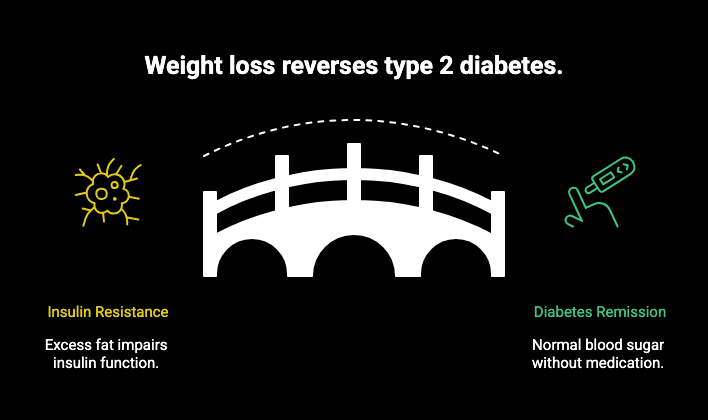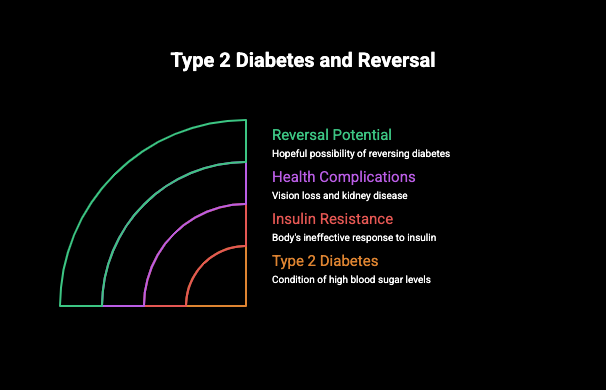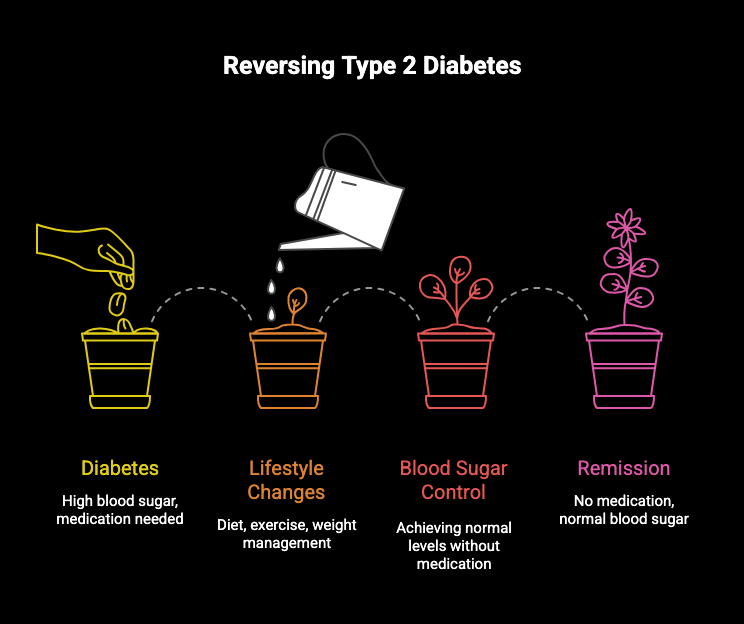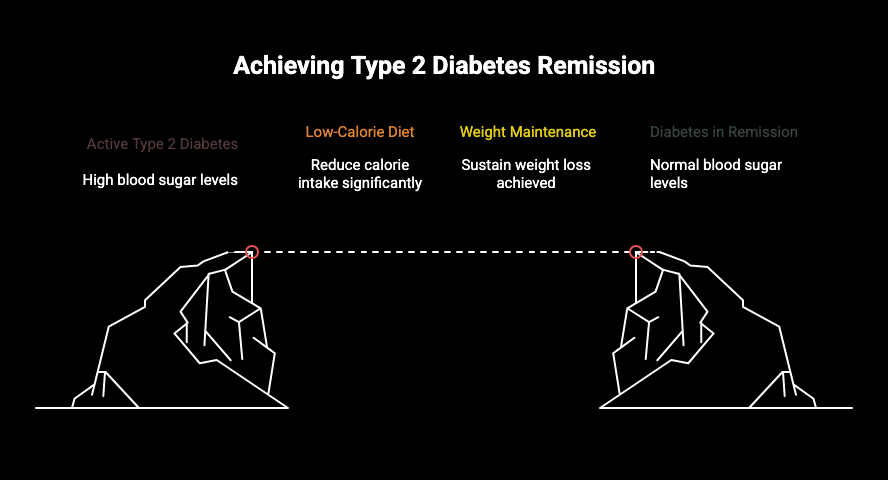
Key Highlights
- Type 2 diabetes is a chronic disease caused by excess fat in the liver and pancreas, leading to insulin resistance.
- While there is no cure, reversal, also known as remission, is possible for many people, especially within the first six years of diagnosis.
- Significant weight loss is the most effective strategy for reversing type 2 diabetes, as it helps reduce the fat that interferes with insulin function.
- Clinical trials like DiRECT have shown that structured weight loss programs can lead to a high rate of diabetes remission.
- Lifestyle changes, including specific diets and regular exercise, are crucial for achieving and maintaining normal blood sugar levels without medication.

Introduction
Have you ever wondered if it’s possible to turn back the clock on a type 2 diabetes diagnosis? This common question touches on a deep hope for many living with this chronic disease. While it may sound too good to be true, science suggests that reversal is a real possibility for many individuals. Managing type 2 diabetes often involves a lifelong commitment, but new research shows that with the right approach, you might be able to normalize your blood sugar and reduce or even eliminate your need for medication.
Understanding Type 2 Diabetes
Type 2 diabetes is a condition defined by high blood sugar levels. It primarily occurs due to insulin resistance, where your body’s cells don’t respond effectively to insulin, the hormone that regulates glucose. This resistance causes sugar to build up in your bloodstream instead of being used for energy.
Over time, elevated blood sugar can lead to serious health complications, including vision loss and kidney disease. While diabetes symptoms can develop slowly, the potential for reversal offers a powerful motivation to take control of your health. So, is it really possible to reverse type 2 diabetes? For many, the answer is a hopeful yes.

Key Causes and Risk Factors
Type 2 diabetes usually stems from a combination of factors, with excess weight being a primary driver. Specifically, fat that accumulates around the stomach, known as visceral fat, is a major contributor to insulin resistance. This condition often goes hand-in-hand with metabolic syndrome, which includes high blood pressure and high cholesterol.
A family history of diabetes also points to a genetic predisposition, increasing your risk. However, it’s crucial to remember that genes are not your destiny. Lifestyle choices play a massive role in whether this predisposition develops into the disease.
Other significant risk factors include:
- A lack of exercise or being physically active less than three times a week.
- Age, with risk increasing for those over 45.
- A history of gestational diabetes.
Losing weight directly combats the primary cause of insulin resistance, making it a powerful tool for reversal.
Defining “Reversal” of Type 2 Diabetes
When we talk about the reversal of this chronic disease, what do we actually mean? Reversal, more accurately termed remission, refers to achieving and maintaining normal blood sugar control without the need for diabetes medications. It’s about managing the condition so effectively through lifestyle that it no longer meets the diagnostic criteria for diabetes.
This concept is different from a cure. Think of it like a slider rather than an on-off switch. Positive changes move the slider away from diabetes, but it can slide back if healthy habits are not maintained. We will now explore what this means in practice and how success is measured.

Scientific Evidence on Type 2 Diabetes Reversal
The idea of reversing type 2 diabetes isn’t just wishful thinking; it’s backed by strong scientific evidence. A breakthrough in understanding the disease revealed it’s caused by excess fat accumulating in the liver and pancreas. Removing this fat can restore normal function, and this has been demonstrated in major studies.
Leading clinical trials and ongoing research continue to build on this knowledge, showing that with the right interventions, remission is an achievable goal for many. Below, we’ll look at the results of these groundbreaking studies and the success people have had in the real world.
Leading Clinical Trials and Their Results
One of the most significant studies providing scientific evidence for reversal is the Diabetes Remission Clinical Trial (DiRECT), conducted in collaboration with Newcastle University and the University of Glasgow. This landmark clinical trial tested whether a structured weight management program delivered in a primary care setting could achieve remission of type 2 diabetes.
The results were remarkable. The study showed that a significant portion of participants could put their diabetes into remission through a low-calorie diet followed by a period of weight maintenance. This trial moved the concept of reversal from a theoretical possibility to a proven therapeutic strategy.
The findings from the DiRECT trial and others like it have reshaped our understanding and treatment of type 2 diabetes across the United States and beyond.

| Trial Feature | DiRECT Trial Result |
|---|---|
| Remission at 1 Year | Nearly half (46%) of participants in the weight loss group achieved remission. |
| Remission at 2 Years | Over a third (36%) of the group remained in remission. |
| Weight Loss | Participants who achieved remission lost an average of over 10 kg (22 lbs). |
| Health Outcomes | The weight loss group experienced fewer serious medical problems. |
Success Rates and Real-World Case Studies
The success rates seen in clinical trials are being mirrored in real-world cases, offering hope to millions. While not everyone achieves remission, a substantial number of people do, especially those who commit to significant weight loss shortly after their diagnosis. Success is most common in the first six years after diagnosis, but it’s never too late to try.
Real-world success stories often share common themes: dedication to a new way of eating, incorporating regular physical activity, and consistent monitoring. These individuals report not only normalized blood sugar levels but also a vastly improved quality of life, more energy, and fewer health concerns.
Key factors linked to successful reversal include:
- Achieving significant weight loss, typically 5-10% of body weight or more.
- Adhering to a structured diet and exercise plan.
- Receiving support from healthcare providers or structured programs.
Challenges and Barriers to Diabetes Reversal
The path to reversing type 2 diabetes is promising, but it’s not without its challenges and barriers. Making and sustaining the significant lifestyle changes required can be difficult. These hurdles can be psychological, social, or economic, and they can impact your ability to achieve and maintain remission.
Understanding these obstacles is the first step to overcoming them. By acknowledging the difficulties, you can better prepare yourself and seek the right support to improve your quality of life and avoid future health complications. Let’s explore some of the common factors that can stand in the way.
Psychological and Emotional Factors
Psychological and emotional factors play a huge role in the journey to reverse diabetes. Stress, anxiety, and depression can all disrupt your ability to stick with lifestyle changes. For many, food is tied to comfort, and stress eating can derail even the best-laid plans.
Making a major shift in your diet and exercise habits requires mental fortitude. It’s common to feel overwhelmed by the scale of the changes needed or discouraged by setbacks. A diagnosis of diabetes can also bring feelings of guilt or failure, even though it’s a complex condition influenced by genetics and environment.
Addressing these emotional factors is just as important as changing your diet. Finding healthy ways to manage stress, seeking support from a therapist or support group, and practicing self-compassion can help you navigate the emotional challenges and stay focused on your health goals.
Maintaining Long-Term Lifestyle Changes
Perhaps the biggest challenge of all is maintaining positive lifestyle changes for the long term. It’s one thing to follow a strict plan for a few months to achieve remission; it’s another to integrate those healthy habits into your life permanently. Life gets busy, motivation can wane, and old habits can creep back in.
Effective lifestyle management is about finding a sustainable balance. A diet that is too restrictive may not be maintainable, leading to a cycle of loss and regain. The key is to build a new routine that you can genuinely enjoy and stick with for years to come.
This requires ongoing effort and mindfulness. Regularly checking in on your goals, finding a support system, and being prepared for setbacks are all part of the long-term journey. The goal is to make these changes a natural part of who you are, not a temporary fix.
Conclusion
In conclusion, the journey toward reversing Type 2 Diabetes is complex and multifaceted. It involves understanding the nuances of the condition, adhering to effective lifestyle changes, and exploring medical options when necessary. While evidence suggests that many individuals can achieve significant improvements through diet, exercise, and other interventions, the path may not be the same for everyone. It’s essential to remain patient and committed, as the process of reversal can take time and requires consistent efforts. If you’re looking to take control of your health and explore personalized strategies for managing or reversing Type 2 Diabetes, get a free consultation with our experts today. Your journey to better health starts now!
Frequently Asked Questions
Can prediabetes be reversed with similar methods?
Yes, prediabetes is highly reversible using the same methods. By making positive lifestyle changes, such as improving your diet and increasing exercise, you can lower your blood sugar levels and restore normal blood sugar control. Taking action on these risk factors early is the best way to prevent prediabetes from progressing to type 2 diabetes.
How long does it typically take to see reversal of symptoms?
The timeline for reversal varies, but many people see significant improvements in their blood sugar levels within a surprisingly short period of time after committing to a weight loss program. Some studies have shown normal fasting glucose levels in as little as one week, with broader health benefits appearing over several months.
Are there risks to attempting diabetes reversal?
Attempting diabetes reversal, especially through very low-calorie diets, should be done under medical supervision. Rapid changes in diet and weight can affect your blood sugar levels and may require adjustments to medications to avoid health complications. Always consult with your primary care provider before starting any new, intensive regimen.


